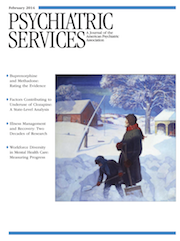This Month’s Highlights
AEB Series: Treatments for Opioid Addiction
Since 1964, specialized clinics across the country have been providing methadone maintenance treatment (MMT) to people dependent on heroin and other opioids. In 2000, Congress passed a law allowing physicians to prescribe approved medications for opioid treatment in other settings, such as their offices. Then, in 2002, the FDA approved high-dose formulations of buprenorphine for maintenance treatment (BMT). Two articles in this issue review a wealth of research evidence that has accumulated regarding MMT and BMT. In the lead article, Catherine Anne Fullerton, M.D., M.P.H., and colleagues rate the evidence as high for MMT’s effectiveness in reducing illicit opioid use, particularly at doses greater than 60 mg. Recent research shows positive impacts on HIV risk behaviors and criminality. The authors call for more studies of the efficacy and safety tradeoffs of very high methadone doses (>100 mg) (page Original article: 146). In the second review, Cindy Parks Thomas, Ph.D., and coauthors also found a high level of evidence for BMT’s effectiveness. Research also indicates that BMT may have a higher safety profile than MMT for pregnant women (page Original article: 158). The two articles are part of the SAMHSA-funded Assessing the Evidence Base (AEB) Series of 14 reviews of commonly used evidence-based interventions for people with serious mental illness. The articles, which were peer reviewed by a special panel of Psychiatric Services reviewers, are being published online ahead of print in Psychiatric Services in Advance and will appear in print issues throughout 2014.
Illness Management and Recovery: A Review
Illness Management and Recovery (IMR) is a standardized psychosocial intervention that is designed to help people with severe mental illness manage their illness and achieve personal recovery goals. A literature review by Alan B. McGuire, Ph.D., and colleagues summarizes evidence for the effectiveness of IMR and describes facilitators and barriers uncovered in IMR implementation studies. The authors conclude that research on IMR as a package is promising and that the intervention leads to positive consumer outcomes. No population has emerged that does not generally benefit from IMR. More work is also necessary to adapt IMR to special populations, such as those involved with the criminal justice system. Studies show that IMR can be implemented with acceptable fidelity, but substantial implementation support may be needed (page Original article: 171).
Reducing Disparities: A Ten-Year Perspective
In 2001, the U.S. Surgeon General published the landmark report Mental Health: Culture, Race, and Ethnicity. That report made several recommendations for further research and for actions in several areas of policy and practice to improve outcomes for racial-ethnic minority groups. In a literature review, Catherine DeCarlo Santiago, Ph.D., and Jeanne Miranda, Ph.D., examine whether progress toward two of these recommendations has been made: the need to train more providers from racial-ethnic minority groups and the need to ensure that racial-ethnic minority groups are represented in randomized trials of clinical interventions. The authors conclude that little progress has been made in developing a more diverse workforce. However, more representation of minority populations in randomized trials is evident, but their numbers often remain too small to analyze (page Original article: 180).
Focus on Medications
In addition to the two AEB Series reviews of medication treatments for addiction, five studies examine use and prescribing of various other medications. In a national data analysis, T. Scott Stroup, M.D., M.P.H., and colleagues found that clozapine, the only antipsychotic approved for treatment-resistant schizophrenia, is rarely used and that geographic factors appear to play a role (page Original article: 186). In a related commentary, Martha Sajatovic, M.D., joins with Stroup and colleagues in calling on clinicians, care systems, policy makers, and consumers to implement ways to reverse clozapine’s underuse (page Original article: 135). Ana R. Quiñones, Ph.D., and colleagues found that among more than 62,000 veterans with chronic depression, those from most minority groups were significantly less likely than white veterans to receive adequate antidepressant treatment. However, findings for psychotherapy were quite different (page Original article: 193). Gail A. Edelsohn, M.D., M.S.P.H., and coauthors examined the appropriateness of psychotropic prescribing for Medicaid-enrolled children with both an intellectual disability and a mental disorder (page Original article: 201). Liang-Jen Wang, M.D., M.P.H., and colleagues found high and rising rates of anxiolytic-hypnotic use in the Taiwanese population (page Original article: 208). Finally, despite generally poor adherence to antidiabetic medications among Texas Medicaid patients, Pooja R. Desai, M.S., and colleagues found significantly better adherence among patients who were also taking antipsychotics, suggesting that the coexistence of a mental illness does not compromise—and may even improve—outcomes of chronic comorbid conditions (page Original article: 215).



